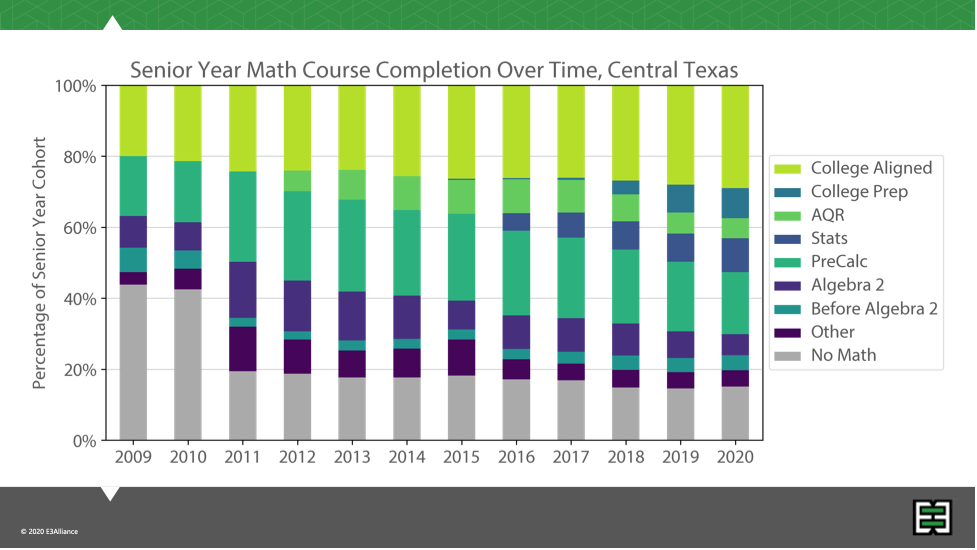
Collective Impact Strategies Succeeding in Central Texas
Institutions across the country are adopting new policies and practices to better align higher education and secondary mathematics pathways to improve student success.
In most states and regions, students can meet high school graduation requirements in mathematics and then immediately enroll in a public two- or four-year higher education institution—but then be told they do not meet the requirements to be placed into a college-level math course. Clearly, our education systems are not aligned.
This misalignment is often unknown, or at least extremely unclear and confusing, to both K–12 and higher education leaders, faculty, staff, students, and families. We must resolve this disconnect in our education systems’ graduation, admissions, and placement policies, and align mathematics course sequences and advising practices. We must remove the array of unnecessary barriers at the transition from high school to college, and ensure that more students enroll and are successful in the mathematics courses they need for higher education credential and degree attainment.
To align math pathways, K–12 and higher education administrative, mathematics, and advising leaders must work together to uncover and resolve these issues at the transition from high school to college.
With support from the Michael & Susan Dell Foundation over the past three years, the Charles A. Dana Center at The University of Texas at Austin and E3 Alliance have taken up the challenge to redefine regional mathematics pathways in Central Texas so that many thousands more students can demonstrate college readiness in mathematics and succeed in college.
Recognizing that student proficiency and success rates in mathematics were much lower than desired in Central Texas, as is unfortunately common across the country, the region’s education leaders decided in 2018 to address the problem directly and established the Central Texas Math Alignment Taskforce (CTXMAT). Since then, CTXMAT has made tangible progress in student course taking patterns and success, developed extensive assessment assets and tools and professional learning tools for district mathematics leaders and their teachers, and informed state level policy.
“It has been inspiring to see the changes taking shape to benefit Central Texas students based on the work of CTXMAT,” said Elisha Smith Arrillaga, Dana Center managing director. “The collective impact strategy of that group is an exemplar for the field.”
A Collaborative Regional Approach
One institution alone could not address the student success rates in mathematics. Therefore, CTXMAT brought together a coalition of cross-sector education leaders that includes the Dana Center, E3 Alliance, and PK–12 districts and postsecondary institutions.
The educational institutions include 13 independent school districts from rural, suburban, and urban areas in Central Texas; two public and four independent universities; and two community colleges. The Central Texas region serves over 285,000 students in PK–12 schools and approximately 125,000 undergraduate students in institutions of higher education (IHEs). The role of E3 Alliance as a trusted, regional education backbone organization was critical in bringing the necessary stakeholders to the table to work toward real change for students, especially those traditionally underserved.
As part of a collective impact initiative, these leaders went beyond informal collaborations. Rather, they worked cohesively to establish a structured process that led to a shared agenda, close communication, trusted relationships, and a plan of action to change policies and practices that would benefit all students.
Developing and Implementing Change Based on Learnings Across Sectors
The region has made steady progress in increasing the number of Central Texas students taking college-aligned mathematics courses, expanding the range of course offerings to better match postsecondary options associated with programs of study, and increasing the number of students taking mathematics in their senior year.

“Our work with CTXMAT has been rewarding in so many ways,” said Susan Dawson, president and executive director of E3 Alliance. “The results we are already seeing would not have been possible without the deep support and collaboration of each and every PK–12 and postsecondary institution involved in this work.”
CTXMAT focused on understanding how the misalignment of secondary to postsecondary happens in many different ways. For example, an early discovery in the work was that high school students are accustomed primarily to multiple-choice assessments, yet college faculty emphasize open-ended responses that require students to show their work. CTXMAT decided to develop multi-part, open-ended performance tasks for five different high school mathematics courses, along with a rubric for students to use to reflect on their own problem-solving processes. Without cross-sector conversations, this potentially comprehensive change to current teaching and learning in classrooms across the entire region would not have been initiated.
Regional mathematics alignment goals and recommendations for the next phase of the work were recently set, which E3 and the Dana Center used to develop a renewed charge that is now signed by superintendents and presidents from 13 districts and 8 institutions of higher education. Additionally, districts and higher education institutions developed individual mathematics alignment goals based on their district or institutional data and shared their progress throughout the year.
“This region-wide collaboration and movement have been incredibly effective,” said Lindsay Fitzpatrick, Dana Center policy lead. “The fact that CTXMAT can work at full scale in the Central Texas region is due to the commitment to one another as leaders, districts, institutions, and community members, all carefully fostered and supported by the tenacious leadership of E3 Alliance. Every community has an organization that can bring all necessary stakeholders to the table for change. It is a matter of identifying that entity and replicating the effective strategies we have seen in Central Texas, modified to fit each local context.”
Looking to the Future
Streamlining the mathematics transition from secondary to postsecondary education is complex and requires a range of policy and practice changes to fully realize this vision. Through work undertaken in 2020–21, CTXMAT set the following regional goals to guide future work and measure year over year.
PK–12 Goal: Students take a math course in their senior year of high school that best prepares them for a successful transition to higher education/career.
- All students default to taking a math course for all four years of high school.
- Increase the percentage of 12th grade students enrolled in and completing a college-aligned math course.
- Decrease the percentage of 12th grade students in Algebra II or below-grade level courses.
- Course-taking patterns will reflect the range of aligned mathematics pathways.
- Students will be equitably enrolled and successful in advanced mathematics courses by race/ethnicity, gender, and income level.
Higher Education Goal: Higher education institutions ensure students take math courses that are best aligned to success in their degree/career expectations.
- Increase the percentage of students enrolling and completing a gateway mathematics course (course for college credit required by programs of study) in their first year of college.
- Course-taking patterns in gateway mathematics will reflect the range of mathematics pathways aligned to programs of study.
- Students will be equitably enrolled and successful in gateway mathematics courses by race/ethnicity, gender, and income level.
This Central Texas collective impact initiative demonstrates how communities can be united to make changes at scale to improve student outcomes. E3 Alliance’s convening power, communication framework, and data collection and analysis—coupled with the Dana Center’s national and statewide reputation, ability to work with faculty and IHE leaders, and mathematics expertise—built a strong backbone. Both organizations’ focus on data, and their facilitation skills, moved a large group of educators and education leaders forward in better aligning mathematics content and instruction.
Such in-depth cross-sector collaboration is not common, but these efforts show the great potential for impact when this type of collaboration is achieved.
Get in Touch
How can the Dana Center work with you to ensure that our nation's students are ready for postsecondary education and the contemporary workforce?
